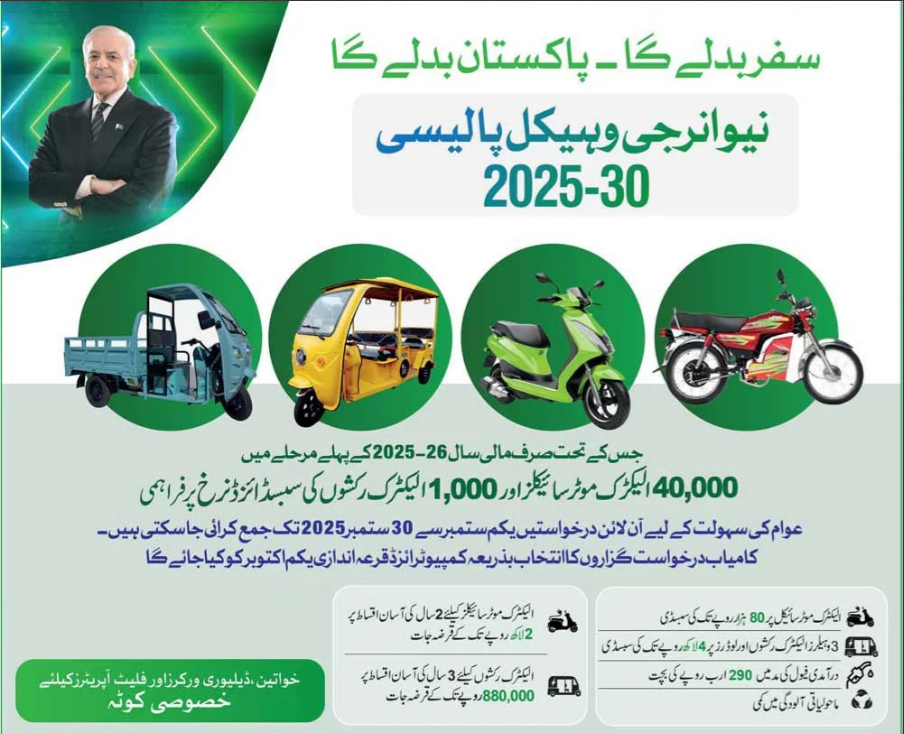National , Incentives, and What You Must Know
Introduction: Shaping Pakistan’s Green Transport Future
In a decisive move towards sustainable mobility, the Government of Pakistan officially launched the National Electric Vehicle (NEV) Policy 2025–30—a comprehensive plan aiming to make 30% of new vehicle sales electric by 2030. The policy, delivered via a fully digital platform, allows users to online apply for subsidies, making it user-friendly, transparent, and accessible.
Key Policy Goals and Benefits
EV Adoption Targets and Environmental Gains
- 30% NEV target by 2030—covering two- and three-wheelers and gradually expanding to four-wheelers
- Expected annual environmental impacts:
- 2.07 billion liters of fuel saved
- USD 1 billion in foreign exchange retained
- 4.5 million tons of carbon emissions avoided
- USD 405 million healthcare cost savings
Financial Incentives & Subsidies
- Initial Rs 9 billion subsidy for FY 2025–26 supporting 116,053 electric bikes and 3,171 electric rickshaws .
- Women’s inclusion: 25% of subsidy reserved for female beneficiaries
- Direct consumer subsidies: Rs 65,000 for two-wheelers; Rs 400,000 for three-wheelers; support for four-wheelers up to Rs 15,000/kWh or 5% of invoice—whichever is lower.
- Funding mechanism: A levy imposed through the New Electric Vehicle Adoption Levy (NEVAL) on new ICE vehicle imports/sales funds EV subsidies and infrastructure .
Infrastructure Rollout & Industry Boost
Charging Network & Smart Technologies
- 40 fast-charging stations along motorways (spaced ~105 km apart) within months of rollout .
- Nationwide targeting of 3,000 charging stations by 2030; oil marketing companies to convert 10% of their stations into EV chargers .
- Incorporation of battery-swapping systems, vehicle-to-grid (V2G) technologies, and mandatory EV charging in new building codes.
- Electricity tariff cuts: EV charger tariffs reduced (e.g., Rs 39.7 per kWh) and slashed by 45% earlier in 2025 to prop up affordable charging.
Supporting Local Manufacturing & SMEs
- Over 90% of parts for e-bikes and e-rickshaws are locally manufactured; locally produced EVs are 30-40% cheaper than imports .
- Government to extend AIDEP preferential tariffs until 2026, phased out by 2030 .
- Customized support packages for SMEs to participate in the EV value chain .
- Regulatory oversight via a steering committee and biannual audits by Auditor General to ensure transparency and performance.
How to Online Apply for NEV Subsidies
Digital Platform – Your Gateway to NEV Benefits
- The policy introduced a fully digital platform—the official method to online apply for EV subsidies, verification, and disbursement .
- Users need basic documents such as:
- CNIC (Computerized National Identity Card)
- Proof of vehicle purchase
- Bank account details (for subsidy disbursement)
- Though the policy is live, some sources suggest the application window may open from 1–30 September 2025 (please verify via official government portal, e.g. PAVE or Ministry of Industries & Production website).
Step-by-Step Online Apply Process (Expectations)
- Visit the official NEV-Policy portal (e.g., PAVE.gov.pk). https://punjab.gov.pk/
- Register using your CNIC & contact information.
- Submit vehicle purchase documents and select subsidy category (e-bike, rickshaw, etc.).
- Await digital verification and subsidy approval.
- Receive disbursement directly into your registered bank account.
(Note: Always confirm details from official government sources before applying.)
Why This Matters – Benefits for Pakistanis
- Cost Savings: Fuel savings help recover EV investment in under 2 years (e.g. Rs 150,000 extra cost for e-bike recouped in ~22 months).
- Health & Environment: Cleaner air, reduced healthcare burden, and alignment with global climate commitments.
- Economic Growth & Jobs: Boost local EV production, create jobs in manufacturing, infrastructure, and tech-driven services.
- Energy Security: Reduced fuel import bill (~Rs 800 billion savings over 25 years) and smarter use of electricity surplus .
- Tech Modernization: Establishing Pakistan as a model electric mobility country; federal EV-only procurement by 2027.
Integrating BYD & Private Sector Momentum
- BYD Pakistan, through Mega Motor Company, plans to assemble EVs locally by mid-2026, with a capacity of 25,000 units annually.
- BYD aims to capture a 30–35% market share and expects Pakistan’s EV market to grow three to four times from 2024 to 2025 .
- Domestic players like Sazgar Engineering are ramping up production of electric rickshaws, contributing to local supply chains .
Final Thoughts
Pakistan’s new energy vehicle policy 2025 30 online apply initiative is more than just EV adoption—it’s a bold leap toward sustainable mobility, local industry growth, and environmental resilience. With digital access, gender-inclusive subsidies, and strong infrastructure commitments, it’s a vital opportunity for individuals and businesses alike.

1 thought on “New Energy Vehicle Policy 2025–30: Online Apply”